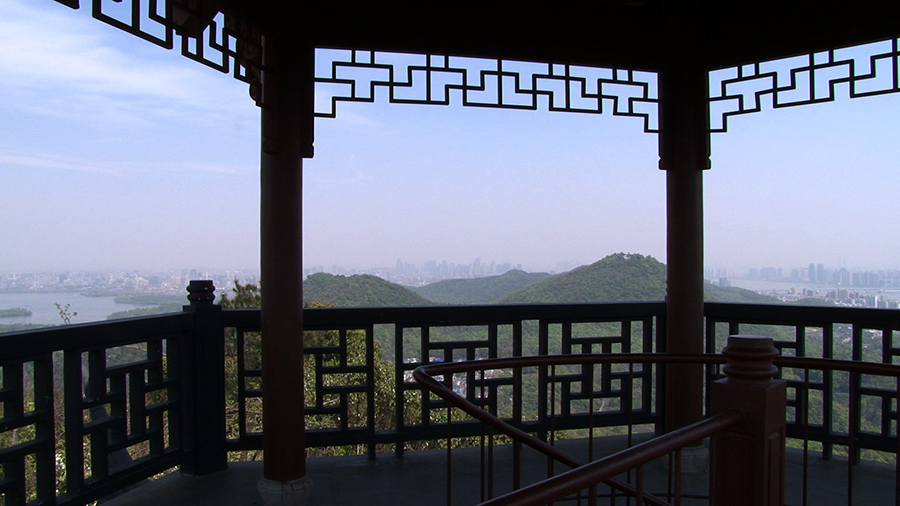Zoom In: Li Ming’s Impromptu Responses to the Policing of Life
The winner of the Hugo Boss Asia Art Award 2017 epitomizes an experimental, almost carefree attitude to filmmaking
The winner of the Hugo Boss Asia Art Award 2017 epitomizes an experimental, almost carefree attitude to filmmaking

In 1975 Muhammad Ali was delivering a lecture to a group of Harvard students when he was asked to recite a poem. His response –'Me, We' –is an intense, concise message about the inherently social nature of human beings.

The artist Li Ming took Ali's poem as the title of his 2015 solo presentation at Beijing's UCCA, which similarly probed the limitations of individual agency. The installation-cum-exhibition featured a number of playfully disorientating elements, including an asphalt road guiding the audience through the work, a video essay that flicked quickly through groups of runners, a bright neon reading 'ME/WE', voice recordings and an essay by critic Guo Juan titled 'The Appearance and Disappearance of a Group of People' (2015). Li's suggestion is that 'there is no I; it is merely an illusion of existence.' Not only was this demonstrated in the images of gaggles of joggers and the audience's flock movement along the asphalt track, but also via the installation's focus on somewhat ominous digital tracking technologies.

Li was born in 1986 in Hunan, southern China. In 2004, he moved to the historic east coast city of Hangzhou to study at the recently opened new media department of the China Academy of Fine Arts. It was here, in 2008, that Li and eight fellow new-media graduates formed the boisterous all-male collective, Double Fly Art Centre – an ongoing influence on Li's ways of working. The group have mock robbed a bank while it was still being built, staged a pantomime massacre at K11 Art Museum in Shanghai and donned masks to join a group performing a public dance to celebrate the opening of a new shop. Beyond anything else, these performances are driven by an idea of spontaneity and improvization: the quality of the filming equipment is not an issue, nor is the apparent absurdity of the action. Double Fly offer a refreshingly nonsensical response to the policing of life experienced by many young Chinese, where a well-trodden path from gaokao (national higher education entrance exam) to graduation to job to marriage to childrearing often feels restrictively predetermined.

In November 2017, Li was awarded the third annual Hugo Boss Asia Art Award for emerging artists. For the prize exhibition, shared with fellow finalists Tao Hui, Yu Ji and Robert Zhao Renhui at Shanghai's Rockbund Museum, the artist constructed an immersive route to guide visitors through a group of his video-installation works. For the earliest of these, Zoom (2014), Li began by steadying a camera from inside his flat in Hangzhou. He used the zoom function on the camera lens to focus on the furthest possible point, whether a well-known landmark, generic building or a field. He then travelled to this location and repeated the process. In all, Li made a 36-stop, 460km journey from Hangzhou to Shanghai; from his apartment to the famous Oriental Pearl Tower on the Bund. There is a satisfyingly amateur sense to the grainy quality of the shaky video, the sense of a kind of impromptu experiment. In accompanying text, Li described the subsequent difficulty of physically locating many of the sites captured by his camera's zoom, explaining that: 'only by various illegal means [could he] reach the top of administrative buildings for shooting.'

Zoom epitomizes the experimental, almost carefree attitude of much of Li's work. As he explained to me over WeChat: 'I don't believe that art should have to use a certain theory or theme as its banner and then move closer to this. If art aims at temporarily solving physiological needs, when it fails it will mean dismissing this art – cruelly, even the artist will be left behind.' The impulse simply to do is the work's driving factor. Yet, despite this professed lack of theoretical concerns, Li's art frequently demonstrates a fresh treatment of time and space, as well as an idiosyncratic reframing of the technologies that we use in daily life, as with his camera's zoom. One result is that the work often has a slant of social investigation and commentary. In Zoom, for instance, the number of official buildings that Li inadvertently focused on – and subsequently had difficulty accessing – speaks of the pervasive and restrictive nature of politics in Chinese daily life.

Rendering the Mind (2017), presented across a series of screens, is one of two new works commissioned for the Rockbund exhibition (along with Inspired by Transliteration - Chapter Two: Emergency Exit, 2017). The star of the video is the historic hotel Broadway Mansions - a 1930s former residence in Shanghai's French Concession, an area well known for its surviving examples of colonial-period architecture. Depictions of the hotel are accompanied by animated blue portraits of architect Bernard Tschumi, whose theories on the properties of space frequently appear at the bottom of the screen. The video jumps to animated renderings of abstract compositions of blocks of colour and lines, with Li often appearing, as he frequently does in his videos, within this geometric space. Rendering the Mind oscillates between a blend of reality/fantasy reminiscent of the film Sin City (2005) and all-out animation, while Tshumi's profound aphorisms on space clash beguilingly with Li's comic interventions. Walking naked in the animated space or strutting, Bruce Nauman-like, along a narrow corridor, Li forges a singular path.
Li Ming is an artist based in Hangzhou, China. The Hugo Boss Asia Art Award show runs at Rockbund Art Museum, Shanghai, China, until 11 February. A solo exhibition of Li’s work opens at Antenna Space, Shanghai, on 24 March 2018.
Li Ming, Rendering the Mind, 2017, film still. Courtesy: the artist and Antenna Space, Shanghai



















